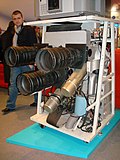Eidophor



An Eidophor was a television projector used to create theater-sized images from an analog video signal. The name Eidophor is derived from the Greek word-roots ‘eido’ and ‘phor’ meaning 'image' and 'bearer' (carrier). Its basic technology was the use of electrostatic charges to deform an oil surface.
Origins and use
The idea for the original Eidophor was conceived in 1939 in Zurich by Dr. Fritz Fischer and the Swiss Federal Institute of Technology, with the first prototype being unveiled in 1943.[1] A patent was granted by the United States Patent and Trademark Office (patent no. 2,391,451) to Friederich Ernst Fischer for the "Process and appliance for projecting television pictures" on 25 December 1945.
Following the Second World War, Paramount Pictures[2][3] and 20th Century Fox[4] experimented with the concept of "theatre television", where television images would be broadcast onto cinema screens.[5] Over 100 cinemas were set up for the project, which failed because of financial losses and the refusal of the U.S. Federal Communications Commission (FCC) to grant theatre owners their own UHF bands for presentation.[6]
An original August 1952 magazine article in the Radio and Television News[7] credits the development of the Eidophor to Dr. Edgar Gretener. It was not until around the time of this article that Gretener took a lead in commercialising the Eidophor, following Fischer’s death in 1947.
Eidophors used an optical system somewhat similar to a conventional movie projector, but substituted a slowly rotating mirrored disk or dish for the film. The disk was covered with a thin film of transparent high-viscosity oil, and through the use of a scanned electron beam, electrostatic charges could be deposited onto the oil, causing its surface to deform. Light was shone on the disc by a striped mirror consisting of strips of reflective material alternating with transparent non-reflective areas. Areas of the oil unaffected by the electron beam would allow the light to be reflected directly back to the mirror and towards the light source, whereas light passing through deformed areas would be displaced and would pass through the adjacent transparent areas and onwards through the projection system. As the disk rotated, a doctor blade discharged and smoothed the ripples in the oil, readying it for re-use on another television frame.

The Eidophor was a large and cumbersome device and not commonly used until there was a need for good-quality large-screen projection. This opportunity arose as part of the NASA space program, where the technology was deployed in mission control.
Eidophors were also used in stadiums by touring music groups for live event visual amplification.
Simple Eidophors produced black-and-white images. Later units used a color wheel (equivalent to the color television standard CBS tried to bring to the market against RCA/NBC's FCC-approved NTSC system, and today's DLP projection system) to produce red, green, and blue fields. The last models produced used separate red, green, and blue units in a single case. The Eidophor was 80 times brighter than CRT projectors of the time. The last Eidophors were able to project colour images of up to 18 metres in width. Advances in projection television technology in the 1990s brought about the end of the Eidophor. The new devices were smaller and cheaper and produced comparable results. Current technologies include the liquid-crystal display (LCD) and digital light processing (DLP) projectors, both of which produce superior results from easily portable devices.
See also
- Comparison of display technology
- Talaria projector
- Telecinema
- Closed-circuit television
- Pay-per-view
Notes
- ^ Winston, Brian, Media Technology and Society, 1998 Routledge, p. 23.
- ^ http://issuu.com/boxoffice/docs/boxoffice_071048
- ^ http://www.terramedia.co.uk/media/cinema-television/cinema_television_chronology.htm
- ^ Ilias Chrissochoidis (ed.), Spyros P. Skouras, Memoirs (1893–1953) (Stanford, 2013), pp. 149–150.
- ^ Gomery, Douglas, Shared Pleasures: A History of Movie Presentation in the United States, 1992 University of Wisconsin Press, p. 233.
- ^ Winston, Brian, Misunderstanding Media, 1986 Taylor & Francis, p. 81.
- ^ [1]
References
- Robertson, A. (1976) Projection Techniques:TV, pp. 149–150, in Video Year Book 1977, Poole, The Dolphin Press.
- Johannes, Heinrich (1989) The History of the EIDOPHOR Large-Screen Television Projector, GRETAG AG, Regensdorf, Switzerland
- Meyer, Caroline (2009) Der Eidophor: Ein Grossbildprojektionssystem zwischen Kino und Fernsehen 1939-1999. (Interferenzen – Studien zur Kulturgeschichte der Technik, 15). Chronos-Verlag, Zurich 2009, ISBN 978-3-0340-0988-1.
External links
- The history and workings of Eidophor projection
- August, 1952 issue of Radio & Television Newsmagazine article discussing Eidophors
- Eidophor: 1950's Steampunk Video Projection Technology, presentation by Mike Harrison at the 2016 Hackaday Belgrade conference
